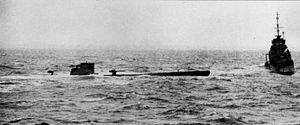- German submarine U-110 (1940)
-

U-110 and HMS BulldogCareer 
Name: U-110 Ordered: 24 May 1938 Builder: AG Weser, Bremen Yard number: 973 Laid down: 1 February 1940 Launched: 25 August 1940 Commissioned: 21 November 1940 Homeport: Lorient, France Fate: Captured, 9 May 1941 General characteristics Class and type: Type IXB U-boat Displacement: Surfaced 1,051 tons tons
submerged 1,178 tonsLength: Overall 76.5 m (251 ft 0 in)
pressure hull 58.7 m (192 ft 7 in)Beam: Overall 6.8 m (22 ft 4 in)
pressure hull 4.4 m (14 ft 5 in)Draught: 4.7 m (15 ft 5 in) Propulsion: Diesel/Electric, 2x MAN M9V40/46 supercharged 9 cylinder diesel engines, 4,400 hp (3,300kW), 2xSSW GU345/34 double acting electric motors, 1000 hp (740kW) Speed: Surfaced 18.2 knots (33.7 km/h)
submerged 7.3 knots (13.5 km/h)Range: Surfaced: 22,200 km (12,000 nmi) at 10 knots
submerged: 118 km (64 nmi) at 4 knots (7 km/h)Test depth: 230 m (750 ft) Complement: 48 to 56 officers & ratings Armament: - 6 x 53.3cm Torpedo tubes: 4 bow, 2 stern (22 torpedoes)
- 1 x Utof 105/45 with 110 rounds
Service record Part of: Kriegsmarine:
2nd U-boat FlotillaCommanders: Kptlt. Fritz-Julius Lemp
(November 1940–May 1941)Operations: 2 patrols Victories: 3 ships sunk for a total of 10,149 gross register tons (GRT)
2 ships damaged for a total of 8,675 GRTGerman submarine U-110 was a Type IXB U-boat of the German Kriegsmarine that operated during World War II. U-110 was captured by the Royal Navy on 9 May 1941 which provided a number of secret cipher documents to the British. U-110's capture, later given the code name "Operation Primrose", was one of the biggest secrets of the war, remaining secret for seven months. President Franklin D. Roosevelt was only told of the capture by Winston Churchill in January 1942.
Contents
Service history
U-110's keel was laid down 1 February 1940 by AG Weser, of Bremen, Germany. She was commissioned 21 November 1940 with Kapitänleutnant Fritz-Julius Lemp in command.
Lemp commanded U-110 for her entire career. In an earlier command (U-30) he was responsible for the sinking of the passenger liner SS Athenia on the first day of the war. The circumstances were such that he was considered for court-martial. He continued, however, to be one of the most successful and rebellious commanders of his day.[citation needed]
U-110 conducted two patrols, sinking three ships totalling 10,149 tons and damaging two others totalling 8,675 tons. On 23 March 1941, her 105 millimetre deck gun exploded during firing, wounding three men. On 9 May 1941, she was captured and later sunk.
In 2007, the submarine's chronometer featured on the BBC programme Antiques Roadshow, from Alnwick Castle, in the possession of the grandson of the captain of the ship which captured her.
Operation Primrose
U-110 and U-201 were attacking convoy OB 318 in the North Atlantic south of Iceland when a torpedo launch failure resulted in Lemp's guard being dropped. In this crisis, the escorting corvette, ASDIC and dropped depth charges.
U-110 survived the attack, but was seriously damaged. After a second depth-charge attack, she surfaced, to the crew's relief, and Lemp announced "Last stop, everybody out", meaning "Abandon ship". As the crew turned out onto the U-boat's deck they came under fire from two attacking destroyers (HMS Bulldog and Hunt) with casualties from gunfire and drowning. The British had believed that the German deck gun was to be used and ceased fire when they realised that the U-boat was being abandoned and the crew would surrender.
The escort commander, Captain Joe Baker-Cresswell in Bulldog, had initially made to ram, but recognising the opportunity for capture, pulled out and hove to, before strafing the submarine. Broadway also closed in, intending to prevent U-110 submerging and suffering incidental damage.
Lemp assumed that the boat, with vents open, would sink, and ordered radio operator Heinz Wilde to leave the codebooks and Enigma machine and get out; he is reported to have said "the U-boat is sinking". Another radio operator recovered personal effects, but left the secret material.
Lemp realised that U-110 was not sinking and attempted to swim back to it to destroy the secret material, but was never seen again. A German eyewitness testified that he was shot in the water by a British sailor, but his fate is not confirmed. Including Lemp, 15 men were killed in the action and 32 captured.
Bulldog's crew, led by sub-lieutenant David Balme,[1] boarded U-110 and stripped it of everything portable on the spot, including her secret documents and Enigma machine. Scotsman William Stewart Pollock, former radio signalman in the Royal Navy and on loan to the HMS Bulldog was on the second boat to board the U-110. He retrieved the Enigma machine and books as they looked out of place in the radio room. U-110 was taken in tow back toward Britain, but sank en route to Scapa Flow.
The documents captured from U-110 helped Bletchley Park codebreakers solve Reservehandverfahren, a reserve German hand cipher.
The film U-571 was partially inspired by the capture of U-110.
References
- Notes
- Bibliography
- Hugh Sebag-Montefiore, Enigma: The Battle for the Code, 2000, ISBN 0-7538-1130-8.
External links
See also
- List of German U-boats
- List of successful U-boat commanders
- Das Boot
- U-571, a film inspired by the capture of U-110
Other captured U-boats
- Type IX U-boats
- U-boats commissioned in 1940
- Captured U-boats
- World War II submarines of Germany
- World War II shipwrecks in the Atlantic Ocean
- 1940 ships
- Ships built in Bremen
Wikimedia Foundation. 2010.
